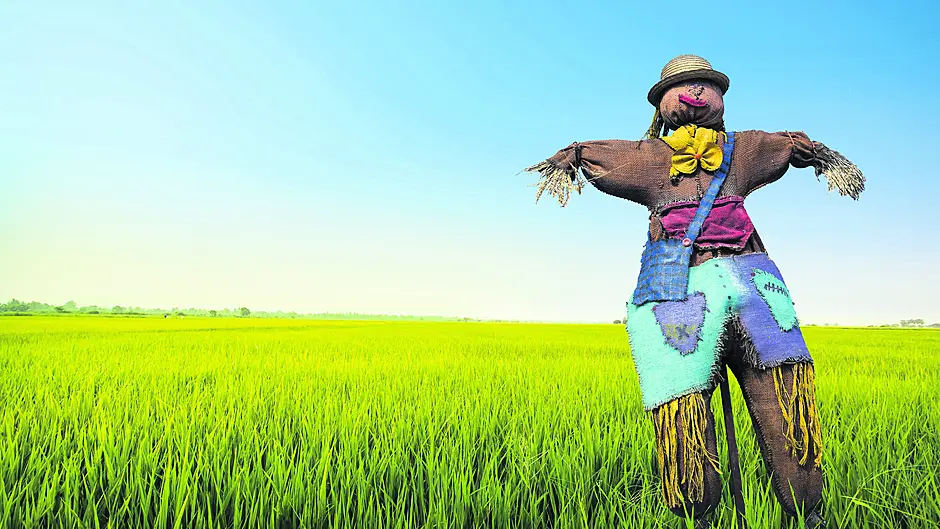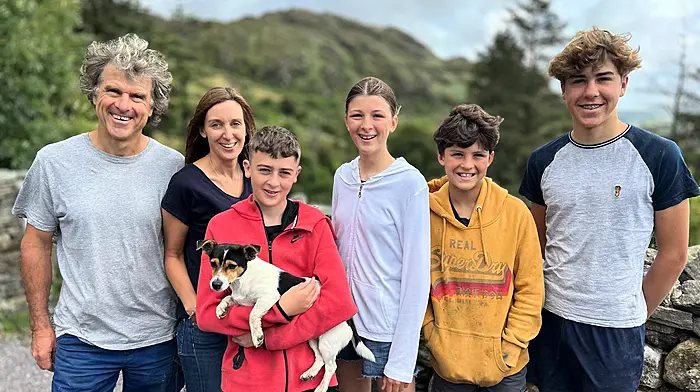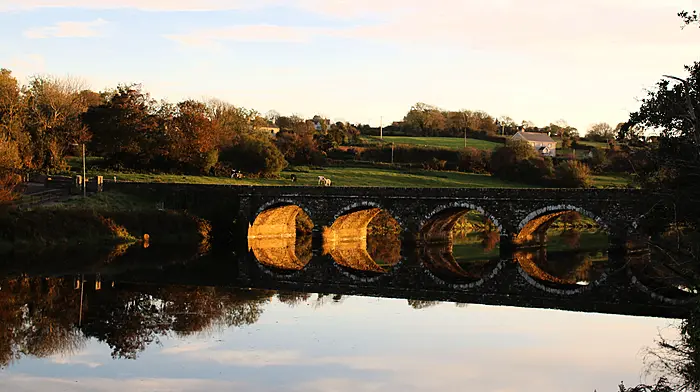
YOUNG boys armed with catapults, spooky figures dressed in filthy rags and bells, truanting schoolgirls wielding clapper blocks, wives brandishing policemen’s rattles, sinister green laser beams … there’s a story behind the scarecrow that will knock the stuffing out of you.
The crow ‘loots mercilessly the potato-garden, the oats bin, the pig trough, the poultry food box, the fruit tree,’complained The Southern Star in April 1926.
A 2023 study confirms that ‘up to 75% of crops’ can be destroyed by birds within 48 hours of harvest.
For thousands of years we’ve been trying to put a stop to these antics.
The ancient Egyptians had the earliest recorded scarecrows – human ones! Boys carrying slings were sent waving and screaming into orchards and fields to scare away golden oriels and quails. One tomb painting depicts two lads standing between heaps of grain, with outstretched arms like today’s scarecrows; another shows two boys with hands cupped over their mouths, apparently making noises to frighten birds.
Native American tribes may also have employed human scarecrows. A watercolour by John White (1585) depicting Secotan, an Algonquin village in North Carolina, shows a straw hut with a raised platform, from which men are believed to have shouted at birds approaching their crops.
This scary business also involved women. In 1900, The Cork Examiner reported that in northern England a farmer used his wife as a scarecrow. ‘Armed with an old-fashioned policeman’s rattle, she performs her extraordinary duties until such hour as her husband fetches her home.’
Like in ancient times, children were sent to run through fields, clapping blocks together, throwing stones and shouting. The excuse of being absent ‘birdscaring’ appears in many logbooks from rural schools in 19th century Britain. In recent times, children have been used to scare off crows from golf courses in Mumbai (Southern Star, 28 March 1970).
 Freya Farmer enjoying the scarecrow festival in Leap last weekend. Photo: Anne Minihane.
Freya Farmer enjoying the scarecrow festival in Leap last weekend. Photo: Anne Minihane.
However, most scarecrows are inanimate, even though they retain a human form. The Ancient Greeks carved wooden statues of Priapus, god of fertility and horticulture, and planted them in vineyards to protect them against thieving birds.
In 8th century Japan, the god Kuebiko, dressed in dirty old rags and bells, topped with rancid meat and putrid fish bones, threatened to devour sparrows entering rice fields.
The problem with the scarecrow is that birds get used to it.
‘The Irish crows did not care much about my father’s scarecrows, or about my clappers. It was only when a few shots were fired at them from guns, and a dozen of them left dead on the field, that they showed any signs of fear…’ wrote one correspondent to The Southern Star in November 1901.
‘Contemptuously indifferent’ to the scarecrow, they even perched on its hat. The creature had become a standing joke, ‘a silent being in dilapidated attendance’, says author Geoff Dyer.
This newspaper suggested alternative strategies to protect crops, and advised that an ‘excellent scarecrow’ could be made from two pieces of glass that would jingle in the
wind.
In the USA after the Second World War, brightly coloured whirligigs became popular. They were sometimes constructed from drinks cans, and revolved like windmills. In 1954 a ‘detonating scarecrow’ reached the European market, and in 1960 the ‘phonoacoustic scarecrow’ made its appearance.
It could shy off ‘obnoxious birds’ using their own anxiety calls recorded on tape. The gas-powered gun or the ‘constantly revolving scarecrow’ provided alternative options.
Having discovered that birds are sensitive to the colour green, a laser scarecrow has recently been designed at Rhode Island University, capable of projecting green light 600ft across a field to startle birds.
As reported in The Southern Star last month, evidence suggests it can reduce the bird population around farmlands by up to 90%.
In the Irish countryside scarecrows have always been a common sight. The earliest reference I’ve found dates from 1893 when a man ridiculed six tasteless statues in a garden he passed, saying the owner might just as well have bought one scarecrow and have done with it.
In January 1924, at the Clonakilty Fancy Dress Festival, Miss Norma Blewitt won a prize for the most original costume, dressed as a scarecrow.
A traveller in 1940 regretted not taking photos of the huge variety of specimens he had witnessed over the years. They included one scarecrow in Co Louth wearing old tweed plus fours and a bowler hat. When questioned about its peculiar dress sense, the farmer replied: ‘The crows wouldn’t know anything about that!’
 The scarecrow made by Natalie Young from Bandon which won the 2019 Leap Scarecrow Festival (Photos: Anne Minihane)
The scarecrow made by Natalie Young from Bandon which won the 2019 Leap Scarecrow Festival (Photos: Anne Minihane)
Today, Ireland hosts several annual scarecrow festivals, notably the ‘All Ireland Scarecrow Festival’ in Durrow, Co Laois.
But in West Cork, the Leap Scarecrow Festival has been held every October since 2015, when ‘scarecrows of all shapes and sizes began appearing in the nooks and crannies of the village’, says its founder, Rita Ryan.
This year’s Festival starts on Monday 23rd October and ends Sunday November 5th.










